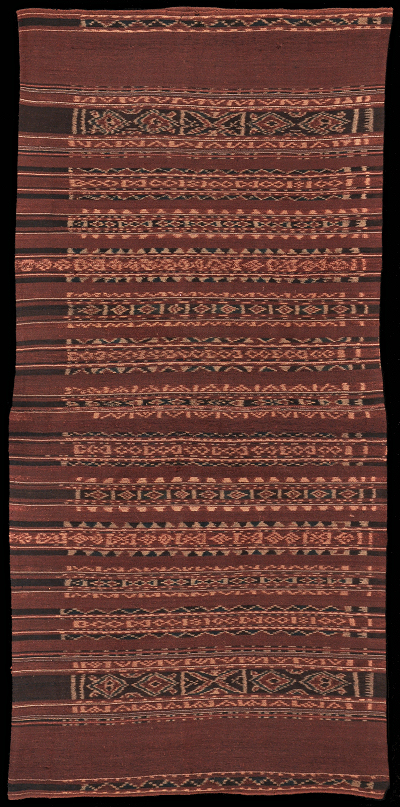| |
131 Solor Archipelago, Lembata
Kewatek (sarong)  
|
| Locale: | Ili Api. Lamaholot people. |
| Period: | Late 19th or early 20th c. |
| Yarn: | Cotton, hand-spun, coarse |
| Technique: | Warp ikat |
| Panels: | 2 |
| Size: | 67 x 145 cm (2' 2" x 4' 9") LW: 2.16 |
| Weight: | 710 g (25.0 oz), 365 g/m2 (1.20 oz/ft2) |
| Design: | Kewatek (ceremonial sarong), most likely kewatek laka dowat, possibly kewatek nai rua. Bands of varying width showing geometrical and figurative motifs, including (probably) cuttlefish. The fact that most motifs are geometrical is typical for the Ili Api style. All hand spun and all natural dyes, indigo and morinda red. |
| Comment: | Strong adat cloth with excellent weaving for the island, unmistakably high status Ili Api. Good condition overall, but with some signs of wear, in the form of patches where the cloth appears to have been roughed up. The weaving has good vertical alignment - an important consideration for its value in adat ceremonies. Cloth is brittle with age, a few tiny holes and thin spots. One old repair (darning) the size of a quarter. General condition very good for its age. |
| Background: | Chapters on Solor Archipelago and Lembata. |
| Published: | Ikat Textiles of the Indonesian Archipelago, 2018.
|
| Compare: | 115 126 047 119 048 |
| Sources: | Nearly identical cloth in Khan Majlis, Woven Messages, Fig. 189. Very similar to those on Fig. 185 and 186. Very similar to 19th C. kewatek in Granucci, Art of the Lesser Sundas, Fig. 109. Similar to kewatek depicted in Maxwell's contribution to Gittinger c.s., Indonesian Textiles, Fig. 8 right, identified as kewatek laka dowat. Similar to two panel sarong identified as watek ohing in Barnes and Hunt Kahlenberg, Five centuries of Indonesian Textiles, p. 347, and to PC 115, but with less perfect definition than either and thirteen rather than nine main ikated bands. |
| |

©Peter ten Hoopen, 2025
All rights reserved.
|


